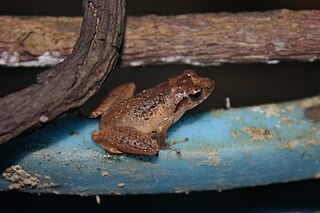
Annam tree frog, also known as the South China tree toad, is a species of frog in the family Hylidae. It is found in southern China, Vietnam, and Laos. The Hainan tree toad from Hainan Island is treated as a subspecies.
The ocellated forest tree frog is a species of frog in the family Arthroleptidae found in Cameroon, the Republic of the Congo, the Democratic Republic of the Congo, Equatorial Guinea, and Gabon, and possibly Angola and the Central African Republic. Its natural habitats are subtropical or tropical moist lowland forest, swamps, and heavily degraded former forests. It is threatened by habitat loss.
Leptobrachium hainanense, the Hainan pseudomoustache toad, is a species of amphibian in the family Megophryidae. It is endemic to the mountains of central and southwestern Hainan Island, China. Before being recognized as a separate species, it was confused with Leptobrachium hasseltii.
Limnonectes liui is a species of frog in the family Dicroglossidae. It is found in Yunnan, China, but it likely occurs also in nearby Laos and Myanmar. The taxonomic placement of this species has been much debated and varies between sources.
Limnonectes fragilis is a species of frog in the family Dicroglossidae. It is endemic to the Hainan Island, China. It is a medium-sized frog, males being 49 mm (1.9 in) and females 52 mm (2.0 in) snout-vent length. Its natural habitats are subtropical or tropical moist lowland forest and rivers. It is threatened by habitat loss.

Amolops torrentis, commonly known as the torrent sucker frog or the little torrent frog is a species of frog in the family Ranidae and genus Amolops that is endemic to China, specifically only on the island of Hainan. They are most likely to be found in streams and surrounding wetland areas. Males have high-pitched mating calls, which are favored by females. Glands on this species' skin can secrete toxins. This species suffers from parasitism and habitat loss. Currently it is listed as vulnerable by the IUCN and is protected by law in China.

Quasipaa exilispinosa is a species of frog in the family Dicroglossidae. It is known under many common names, including Hong Kong spiny frog, common spiny frog, lesser spiny frog, little spiny frog, and Hong Kong paa frog. It has a patchy distribution in southern China including Hong Kong. Its natural habitats are subtropical hill streams in forests or shrublands, and sometimes also seepages, stream-fed marshes, and forests. It is threatened by over-collecting for human consumption and by habitat loss.
Nanorana yunnanensis, commonly known as Yunnan paa frog, Yunnan spiny frog, Bourret's paa frog or Bourret's frog, is a species of frog in the family Dicroglossidae. It is found in southwestern China, Vietnam, Myanmar, northern Thailand, and likely in the intervening Laos. Its natural habitats are small and large streams in montane forests, scrub vegetation and grasslands, and it has also been found in ditches. It is threatened primarily by collection for human consumption, but also by habitat loss caused by agricultural development and infrastructure development.
Odorrana exiliversabilis is a species of frogs in the family Ranidae that is endemic to southeastern China where it is found in Fujian, western Zhejiang, and southern Anhui provinces. These frogs can be found in mountain forest streams and are common in suitable habitat. The species is not considered threatened by the IUCN.
Odorrana hainanensis is a species of frogs in the family Ranidae that might be endemic to Hainan Island, China; there is one record from Guangxi. Prior to its description in 2001, it was confused with Odorrana andersonii.
Odorrana nasuta is a species of frog in the family Ranidae that is endemic to Hainan, China. It occurs near streams in forested regions at elevations of 350–850 m (1,150–2,790 ft) asl. Breeding takes place in streams. It is threatened by habitat loss caused by smallholder farming activities and clear-cutting of forests.
Buergeria oxycephala is a species of frog in the family Rhacophoridae. It is endemic to Hainan Island, China.
Liuixalus hainanus is a species of frog in the family Rhacophoridae. It is endemic to Hainan Island, China, and only known from its type locality, Mount Diaoluo in Lingshui Li Autonomous County.
Raorchestes menglaensis is a species of frog in the family Rhacophoridae. Only known from its type locality, Zhishihe in Mengla County, it is endemic to Yunnan, China, although it is expected to occur more widely, including adjacent Laos.

Kurixalus bisacculus is a species of frog in the family Rhacophoridae. It is found in Southeast Asia and southern China. Because of confusion with other species, the distribution is not well mapped but includes Thailand, Cambodia, Laos, Vietnam, and China. Populations from Hainan were formerly treated as a separate species, Rhacophorus hainanus, but molecular data suggest they are conspecific with Kurixalus bisacculus.

Theloderma corticale is a species of frog in the family Rhacophoridae. It is found in northern Vietnam, south–central Laos, and southern China.
Gracixalus gracilipes, commonly known as the Chapa bubble-nest frog, black eye-lidded small tree frog, yellow and black-spotted tree frog or slender-legged bush frog, is a species of shrub frog from northern Vietnam, southern China, and northwestern Thailand.
Zhangixalus yinggelingensis is a species of frog in the family Rhacophoridae endemic to Yinggeling National Nature Reserve, Hainan, China. Its specific name refers to the type locality, Yinggeling, a mountain range in central Hainan.

Liuixalus is a small genus of rhacophorid frogs that are distributed in southern China. Some species now in Liuixalus were originally placed in Philautus. It is thought to be the most basal genus in the Rhacophorinae.
Liuixalus shiwandashan is a species of frog in the family Rhacophoridae. It is endemic to China. It has been observed in exactly one place: Mount Shiwanda in Guanxi Province, 937 meters above sea level.






